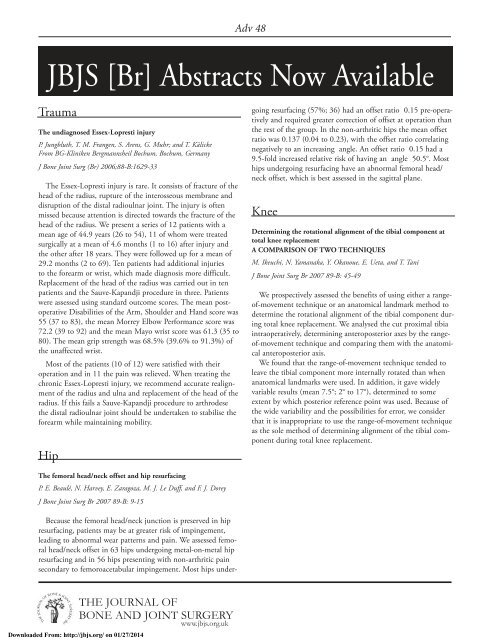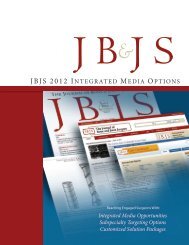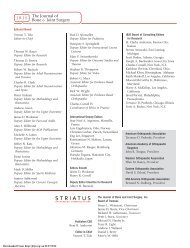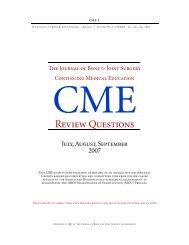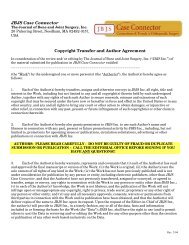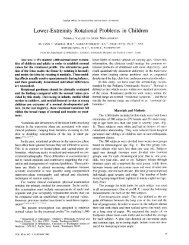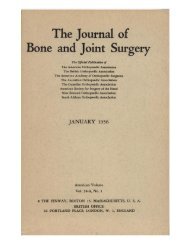Front Matter - The Journal of Bone & Joint Surgery
Front Matter - The Journal of Bone & Joint Surgery
Front Matter - The Journal of Bone & Joint Surgery
Create successful ePaper yourself
Turn your PDF publications into a flip-book with our unique Google optimized e-Paper software.
Adv 48<br />
JBJS [Br] Abstracts Now Available<br />
Trauma<br />
<strong>The</strong> undiagnosed Essex-Lopresti injury<br />
P. Jungbluth, T. M. Frangen, S. Arens, G. Muhr; and T. Kälicke<br />
From BG-Kliniken Bergmannsheil Bochum, Bochum, Germany<br />
J <strong>Bone</strong> <strong>Joint</strong> Surg (Br) 2006;88-B:1629-33<br />
<strong>The</strong> Essex-Lopresti injury is rare. It consists <strong>of</strong> fracture <strong>of</strong> the<br />
head <strong>of</strong> the radius, rupture <strong>of</strong> the interosseous membrane and<br />
disruption <strong>of</strong> the distal radioulnar joint. <strong>The</strong> injury is <strong>of</strong>ten<br />
missed because attention is directed towards the fracture <strong>of</strong> the<br />
head <strong>of</strong> the radius. We present a series <strong>of</strong> 12 patients with a<br />
mean age <strong>of</strong> 44.9 years (26 to 54), 11 <strong>of</strong> whom were treated<br />
surgically at a mean <strong>of</strong> 4.6 months (1 to 16) after injury and<br />
the other after 18 years. <strong>The</strong>y were followed up for a mean <strong>of</strong><br />
29.2 months (2 to 69). Ten patients had additional injuries<br />
to the forearm or wrist, which made diagnosis more difficult.<br />
Replacement <strong>of</strong> the head <strong>of</strong> the radius was carried out in ten<br />
patients and the Sauve-Kapandji procedure in three. Patients<br />
were assessed using standard outcome scores. <strong>The</strong> mean postoperative<br />
Disabilities <strong>of</strong> the Arm, Shoulder and Hand score was<br />
55 (37 to 83), the mean Morrey Elbow Performance score was<br />
72.2 (39 to 92) and the mean Mayo wrist score was 61.3 (35 to<br />
80). <strong>The</strong> mean grip strength was 68.5% (39.6% to 91.3%) <strong>of</strong><br />
the unaffected wrist.<br />
Most <strong>of</strong> the patients (10 <strong>of</strong> 12) were satisfied with their<br />
operation and in 11 the pain was relieved. When treating the<br />
chronic Essex-Lopresti injury, we recommend accurate realignment<br />
<strong>of</strong> the radius and ulna and replacement <strong>of</strong> the head <strong>of</strong> the<br />
radius. If this fails a Sauve-Kapandji procedure to arthrodese<br />
the distal radioulnar joint should be undertaken to stabilise the<br />
forearm while maintaining mobility.<br />
Hip<br />
going resurfacing (57%; 36) had an <strong>of</strong>fset ratio 0.15 pre-operatively<br />
and required greater correction <strong>of</strong> <strong>of</strong>fset at operation than<br />
the rest <strong>of</strong> the group. In the non-arthritic hips the mean <strong>of</strong>fset<br />
ratio was 0.137 (0.04 to 0.23), with the <strong>of</strong>fset ratio correlating<br />
negatively to an increasing angle. An <strong>of</strong>fset ratio 0.15 had a<br />
9.5-fold increased relative risk <strong>of</strong> having an angle 50.5°. Most<br />
hips undergoing resurfacing have an abnormal femoral head/<br />
neck <strong>of</strong>fset, which is best assessed in the sagittal plane.<br />
Knee<br />
Determining the rotational alignment <strong>of</strong> the tibial component at<br />
total knee replacement<br />
A COMPARISON OF TWO TECHNIQUES<br />
M. Ikeuchi, N. Yamanaka, Y. Okanoue, E. Ueta, and T. Tani<br />
J <strong>Bone</strong> <strong>Joint</strong> Surg Br 2007 89-B: 45-49<br />
We prospectively assessed the benefits <strong>of</strong> using either a range<strong>of</strong>-movement<br />
technique or an anatomical landmark method to<br />
determine the rotational alignment <strong>of</strong> the tibial component during<br />
total knee replacement. We analysed the cut proximal tibia<br />
intraoperatively, determining anteroposterior axes by the range<strong>of</strong>-movement<br />
technique and comparing them with the anatomical<br />
anteroposterior axis.<br />
We found that the range-<strong>of</strong>-movement technique tended to<br />
leave the tibial component more internally rotated than when<br />
anatomical landmarks were used. In addition, it gave widely<br />
variable results (mean 7.5°; 2° to 17°), determined to some<br />
extent by which posterior reference point was used. Because <strong>of</strong><br />
the wide variability and the possibilities for error, we consider<br />
that it is inappropriate to use the range-<strong>of</strong>-movement technique<br />
as the sole method <strong>of</strong> determining alignment <strong>of</strong> the tibial component<br />
during total knee replacement.<br />
<strong>The</strong> femoral head/neck <strong>of</strong>fset and hip resurfacing<br />
P. E. Beaulé, N. Harvey, E. Zaragoza, M. J. Le Duff, and F. J. Dorey<br />
J <strong>Bone</strong> <strong>Joint</strong> Surg Br 2007 89-B: 9-15<br />
Because the femoral head/neck junction is preserved in hip<br />
resurfacing, patients may be at greater risk <strong>of</strong> impingement,<br />
leading to abnormal wear patterns and pain. We assessed femoral<br />
head/neck <strong>of</strong>fset in 63 hips undergoing metal-on-metal hip<br />
resurfacing and in 56 hips presenting with non-arthritic pain<br />
secondary to femoroacetabular impingement. Most hips under-<br />
Downloaded From: http://jbjs.org/ on 01/27/2014<br />
THE JOURNAL OF<br />
BONE AND JOINT SURGERY<br />
www.jbjs.org.uk


